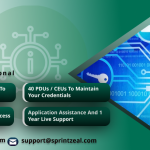In the ever-evolving landscape of cybersecurity, the Certified Information Systems Security Professional (CISSP) certification stands as a beacon of proficiency and expertise. Regarded as one of the most prestigious credentials in the field, CISSP validates individuals’ mastery of a broad array of cybersecurity principles and practices. However, achieving this certification demands rigorous preparation and a comprehensive understanding of the exam’s nuances. Here, we delve into five essential strategies to keep in mind when preparing for the CISSP certification exam.
1. Understand the Exam Blueprint:
Before diving into preparation, aspiring CISSP candidates must thoroughly understand the exam blueprint. The CISSP certification exam covers eight domains, each representing a crucial aspect of cybersecurity:
- Security and Risk Management
- Asset Security
- Security Architecture and Engineering
- Communication and Network Security
- Identity and Access Management (IAM)
- Security Assessment and Testing
- Security Operations
- Software Development Security
Familiarizing oneself with these domains and their respective weightage in the exam is paramount. It helps in devising a structured study plan and allocating time and resources efficiently to each domain based on its importance and complexity.
2. Leverage Comprehensive Study Resources:
The breadth and depth of knowledge required for the CISSP exam necessitate leveraging diverse study resources. From textbooks and online courses to practice tests and forums, candidates must explore a variety of materials to gain a well-rounded understanding of the exam topics. Recommended resources include:
- Official CISSP Study Guide: Authored by (ISC)², the organization behind the CISSP certification, the official study guide provides comprehensive coverage of all exam domains.
- Online Training Courses: Platforms like Cybrary, Udemy, and Coursera offer CISSP preparation courses taught by industry experts.
- Practice Tests: Utilize practice tests and quizzes to assess your knowledge, identify weak areas, and familiarize yourself with the exam format.
- Community Forums: Engage with CISSP forums and online communities to seek advice, share experiences, and clarify doubts with fellow aspirants and certified professionals.
By harnessing a diverse range of study resources, candidates can gain a deep understanding of the exam topics and enhance their preparedness for the CISSP certification journey.
3. Adopt a Multifaceted Study Approach:
CISSP exam preparation demands a multifaceted study approach that combines theoretical knowledge with practical application. While theoretical understanding forms the foundation, hands-on experience and real-world scenarios are equally vital. Here’s how candidates can adopt a multifaceted study approach:
- Read Extensively: Delve into textbooks, whitepapers, and industry publications to grasp theoretical concepts and best practices.
- Hands-On Practice: Set up virtual labs or utilize cybersecurity platforms to gain practical experience in implementing security controls, analyzing vulnerabilities, and mitigating threats.
- Case Studies and Scenarios: Solve case studies and scenario-based questions to apply theoretical knowledge to real-world situations, honing your analytical and problem-solving skills.
- Peer Discussions: Engage in group discussions, study circles, or online forums to exchange ideas, debate concepts, and learn from peers’ perspectives.
By integrating theoretical learning with hands-on practice and collaborative learning, candidates can develop a holistic understanding of cybersecurity principles and enhance their readiness for the CISSP exam.
4. Focus on Weak Areas and Exam Readiness:
As candidates progress through their CISSP preparation journey, it’s crucial to identify and address weak areas promptly. Regularly assess your knowledge through practice tests, quizzes, and self-assessment tools to pinpoint areas that require improvement. Allocate additional time and resources to reinforce these weak areas, whether through targeted study sessions, hands-on practice, or seeking mentorship from experienced professionals.
Furthermore, as the exam date approaches, shift your focus towards exam readiness strategies. Develop a solid exam-taking strategy, including time management techniques, question prioritization, and stress management tactics. Familiarize yourself with the exam format, question types, and scoring methodology to minimize surprises on exam day and maximize your performance.
5. Embrace a Growth Mindset and Persistence:
Preparing for the CISSP certification exam is a challenging yet rewarding endeavor that demands resilience and perseverance. Embrace a growth mindset, viewing challenges as opportunities for growth and learning. Stay motivated and disciplined throughout the preparation process, setting realistic goals and milestones to track your progress.
In moments of doubt or setbacks, remind yourself of your intrinsic motivation and the long-term benefits of achieving CISSP certification. Seek support from peers, mentors, or support groups to stay motivated and accountable. Remember that success in the CISSP exam is not merely about passing a test but about acquiring invaluable knowledge and skills that will propel your cybersecurity career forward.
In conclusion, mastering the CISSP certification exam requires a combination of strategic preparation, comprehensive study, practical experience, and resilience. By understanding the exam blueprint, leveraging diverse study resources, adopting a multifaceted study approach, focusing on weak areas, and embracing a growth mindset, aspiring CISSP candidates can enhance their readiness and maximize their chances of success. With diligent preparation and determination, you can join the ranks of certified information security professionals and make significant contributions to the field of cybersecurity.











